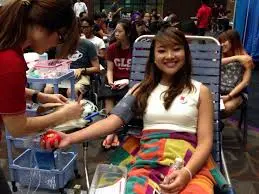Blood donation is the voluntary act of giving blood, mainly for transfusion. Blood transfusion replaces blood that is lost due to trauma or major surgeries, and may be used in the treatment of certain blood disorders. These blood disorders include:
- Anaemia
- Thrombocytopenia
- Leukaemia
- Thalassaemia
World Blood Donor Day happens on 14 June every year. Read on more to find out the importance of donating blood and why we are all encouraged to go for blood donation.
Why is blood donation important?
Globally, blood supply demands are high, and supplies are scarce. For instance, in the U.S., every 2 seconds, someone needs blood and/or platelets. As of 2019, blood inventories in the US routinely fall to critical levels—or less than 2 days of blood on hand. In Singapore, 14 units of blood is required every hour, with 6 days reserve of blood supply available in 2021.
Studies have shown that in South Asian countries, blood donation rates are low, possibly due to lack of awareness about its benefits, poor planning and policy, poor leadership and lack of trained staff for collecting blood. Based on samples of 1000 people, the blood donation rate is 31.5 donations in high-income countries, 15.9 donations in upper-middle-income countries, 6.8 donations in lower-middle-income countries and 5.0 donations in low-income countries.
Furthermore, blood has a very short shelf life – 5 days for platelets and 6 weeks for red blood cells.
As many countries rely on altruistic donations to maintain their blood banks, there is a pressing need to educate people about the importance and benefits of blood donation to ensure sufficient and safe blood supplies.
Conditions Requiring Blood Transfusion
Blood donation is important due to the fact that it can save lives. Conditions such as thalassaemia and blood cancers require huge amount of blood for treatment on a regular basis. The table below by Red Cross Singapore show roughly the amount of blood required:

*Image courtesy of Red Cross Singapore
What are the advantages of blood donation?
Free health screening
Anyone who wishes to donate blood must first undergo a simple physical examination and blood test to check blood pressure, heart rate and haemoglobin level respectively.
After blood is collected, blood will be screened for group type, compatibility for patients, as well as for infectious diseases e.g. HIV, Syphilis, Hepatitis C, Hepatitis B, Zika virus.
This can help to detect health conditions e.g. high/low blood pressure, anaemia or infectious diseases which may otherwise have gone unnoticed.
Contribute to society
Donating one unit of blood may save the lives of up to 3 people. The blood collected may be processed into 3 components:
- Red Blood Cells: used to treat severe symptomatic anaemia e.g. in sickle cell disease
- Platelets: used to prevent bleeding due to low platelet counts e.g. from dengue fever, leukaemia or chemotherapy
- Fresh Frozen Plasma: used to help manage/prevent bleeding, especially where there is deficiency in blood clotting factors e.g. severe burns, liver failure.
How do I prepare for blood donation?
Eat a healthy diet
In the weeks before your donation, build a healthy level of iron in your body by consuming iron-rich foods such as spinach, red meat, eggs and raisins.
On the day of donation, make sure you have eaten something or have a light meal 3 hours before donation.
Drink plenty of fluids
Blood is composed largely of fluid. Hence, drink plenty of non-alcoholic fluids starting from the day before donation to ensure sufficient hydration. Dehydration in the body can cause dizziness and make you faint.
Take proper rest
You should sleep for 7-8 hours the night before donating the blood.
Wear something comfortable
Ensure your sleeves can easily be rolled up above the elbow.
What are some post-donation care tips?
There are certain tips you can follow after your donation is done:
- Once the blood donation is complete, a bandage will be placed where the needle was inserted. Apply firm pressure on the needle insertion site for ≥5 minutes and keep the bandage in place for the next 4 hours.
- If bleeding continues after placing the bandage, keep your arms raised above your heart for ≥20 minutes to stop the bleeding.
- If there is bruising, you can apply an ice pack wrapped in moist cloth on the affected area up to 20 minutes at a time, 3 times a day for the next 24 to 48 hours.
- Limit the use of the ‘donation arm’ for heavy work for 48-72 hours after donation.
- Rest ≥20 minutes at the blood bank after donation.
- If you feel faint, lie down and elevate your legs.
- Take care to stand up slowly after resting.
- Avoid standing for long periods or strenuous activity for 24 hours after donation.
- Get adequate rest so that the body can recuperate.
- Drink plenty of water or non-alcoholic drinks to aid restoration of blood.
- The average adult has 4 to 5 litres of blood. Each donation removes only about 8 to 12% of total blood volume.
- For healthy individuals with sufficient iron stores, adequate hydration will ensure blood volume reverts to normal in 3 days and red blood cells are replenished within 3 to 4 weeks.
Give blood, give life!
Blood donation is relatively risk-free, and the entire process from registration to recovery takes only around 2 hours. More people should be encouraged to donate blood and save lives!
